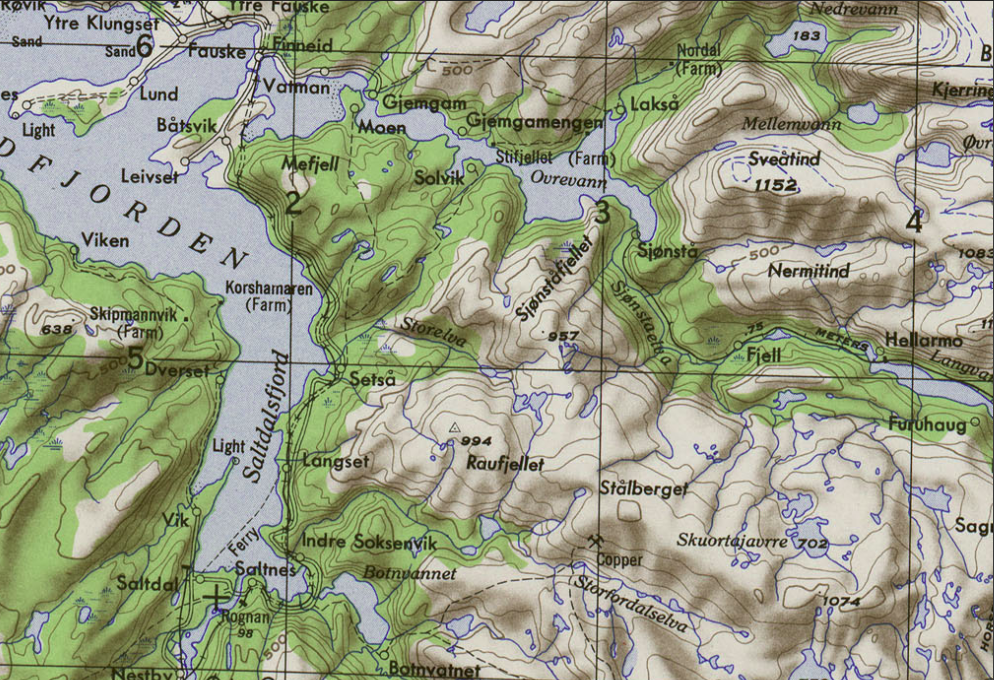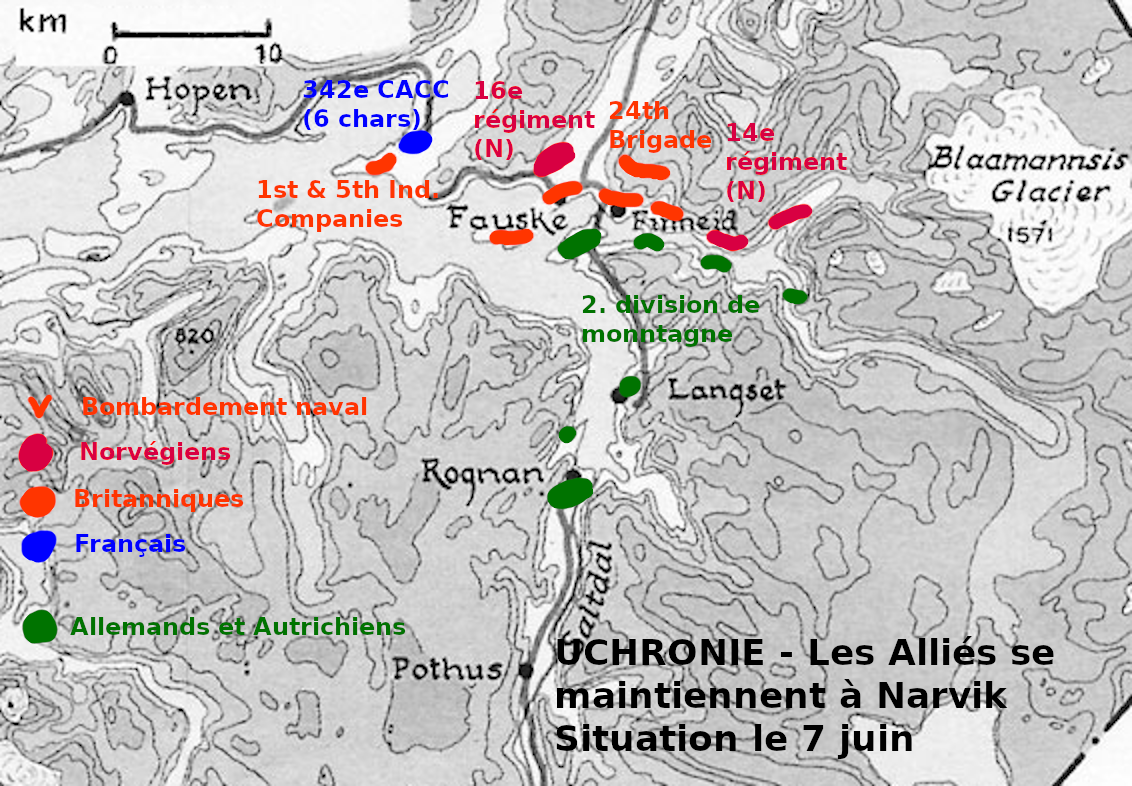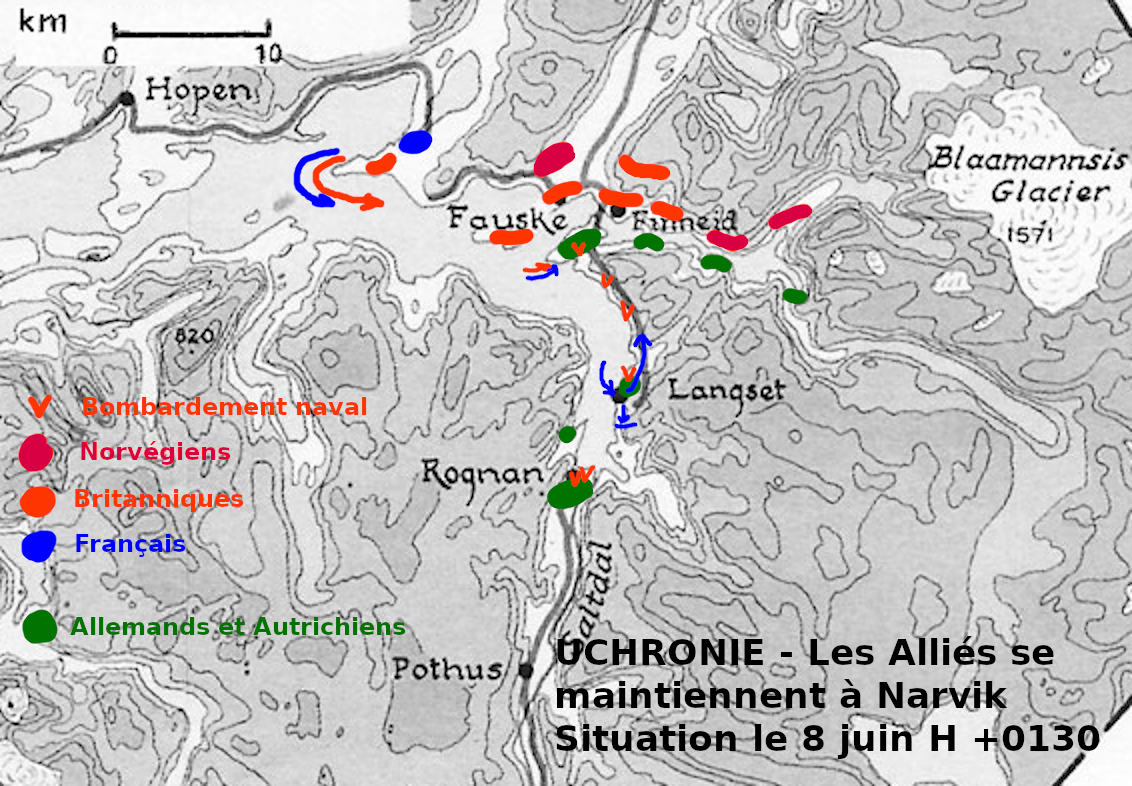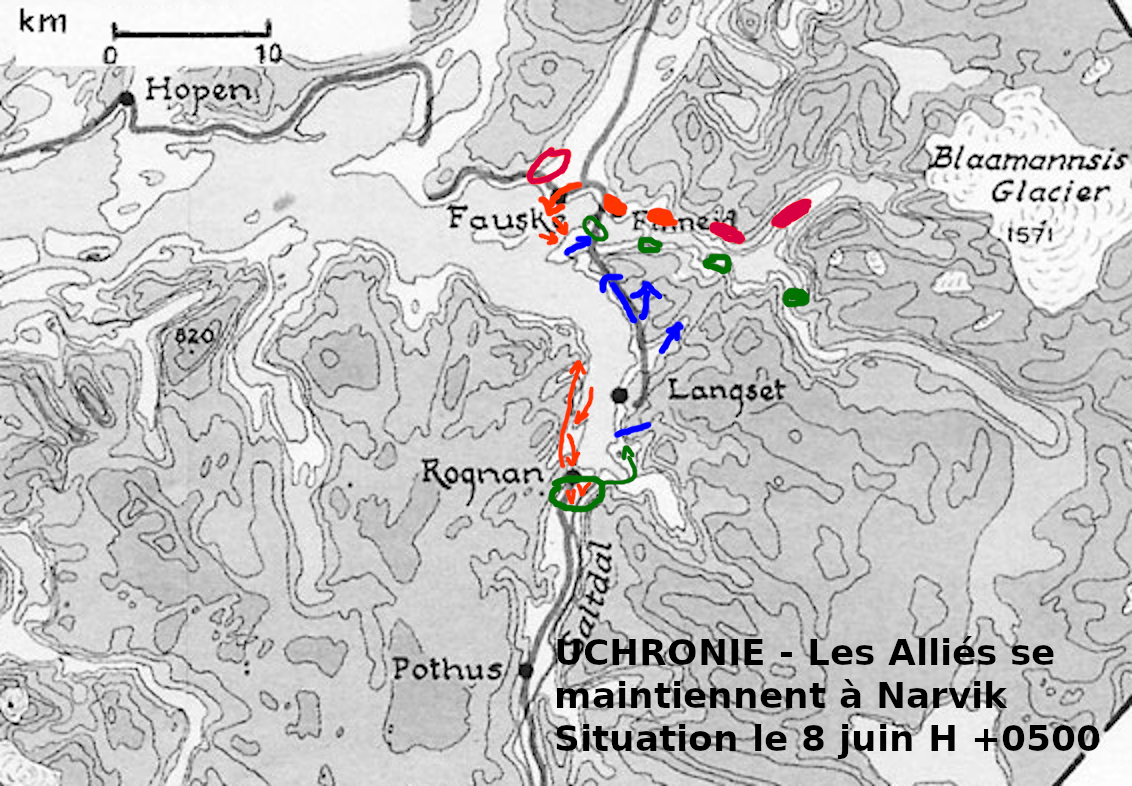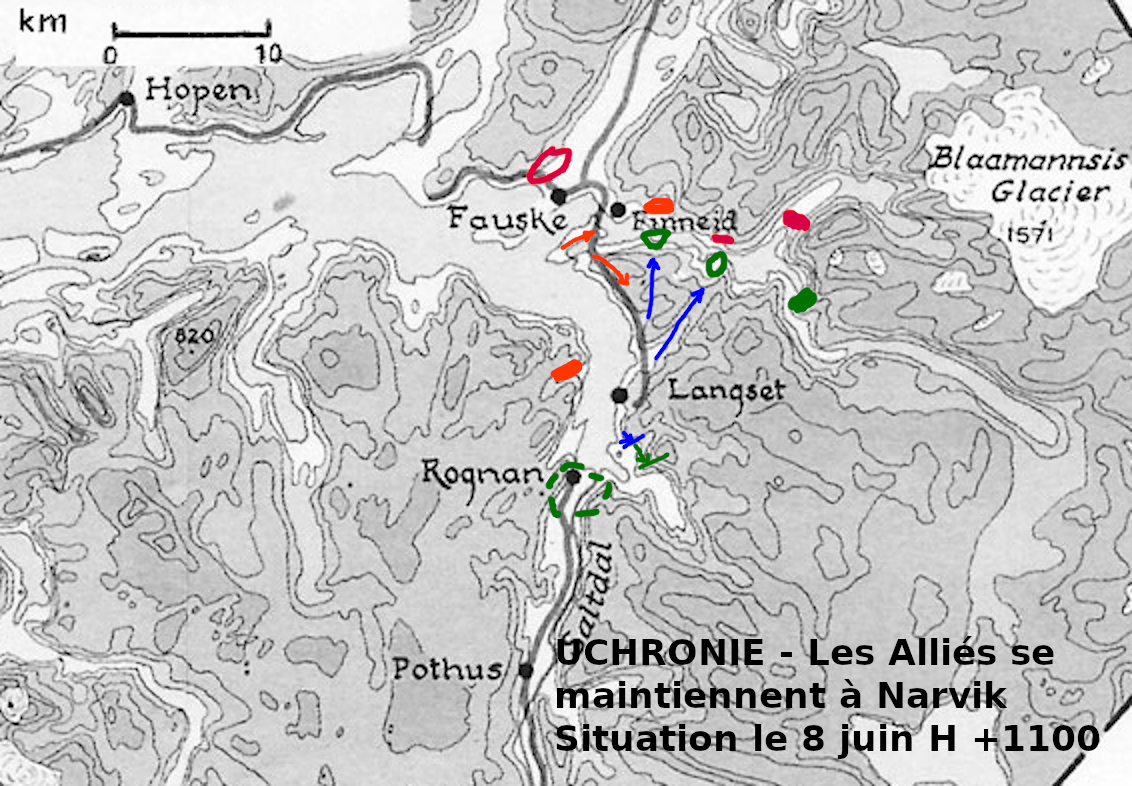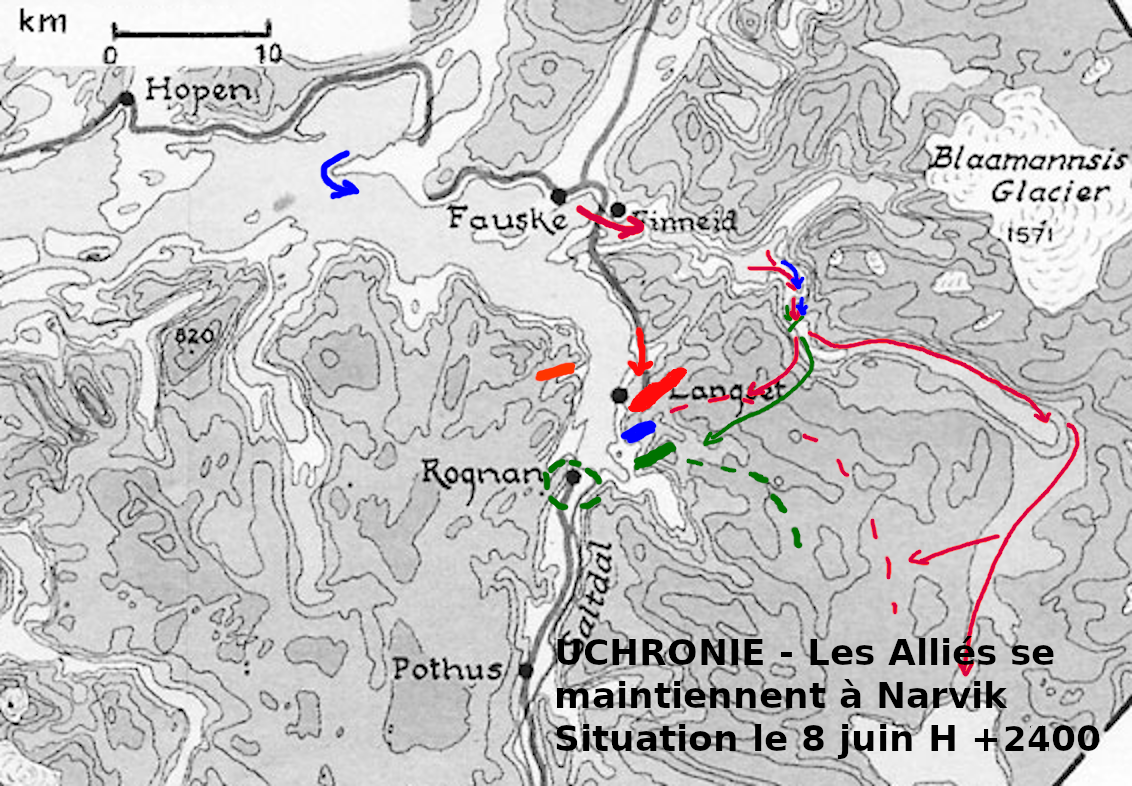Post by DMZ on Nov 3, 2021 18:35:23 GMT
French are getting used to it
May 29 - Headquarters of the allied forces in Harstad
General Antoine Béthouart presents the situation:
"Dietl's 3rd Mountain Division is now pressed from all sides, but the progress of our troops is difficult in a very rugged rocky terrain still covered with snow for the most part. General Dietl has tightened his position and relies on the topography for his defense, every meter gained costs us dearly.
To break through the last resistance, we would have to renew the amphibious assault, this time at the bottom of the Rombaken fjord, which would allow us to strike at the heart of the enemy's position by moving up towards the Katterat railway station in the village of Hundalen to turn the southern defences of the German pocket. We can hope for a disorganization of the entire southern flank."
Admiral Lord William Henry Dudley Boyle, Earl of Cork and Orrery, commander of the Franco-British naval forces, who had been advocating a direct assault on Narvik since the beginning of the operation, approved and promised the support of the Royal Navy even in the tight waters of the fjord bottom.
Captain Loben E. H. Maund, Chief of Naval Staff, former head of the Inter-Service Training and Development Centre (ISTDC), which was responsible for developing methods and equipment for combined operations, was not to be outdone and finally saw his work come to fruition day after day.
General Claude Auchinleck, although not directly concerned because all British land forces are now on the Bodø front, fully supports the idea. As well as the Norwegian General Carl Gustav Fleischer -whose two brigades suffered the most in an open terrain- who also saw the opportunity to finish quickly and to shift the effort to the south.
General Sylvestre-Gérard Audet, commander of the French Expeditionary Corps in Scandinavia (CEFS) was satisfied, not that he feared a refusal - relations between the Allies and the Norwegians were excellent, especially since Auchinleck had replaced General Mackesy, who had had differences of opinion with Admiral Boyle - but he was comforted by the speed and unanimity of the reaction of the participants.
The operation started on 2 June shortly before midnight to limit the air risk, as Værnes was in a short period of darkness at that time, whereas it was daylight in Narvik and Bardufoss; there could be Allied cover, but even if they asked for help, the German planes would not be able to take off quickly.
The 13th Legion Half-Brigade, now experienced in landing under enemy fire, will be in charge of the operation.
Opposing troops will be fixed by assaults beginning half an hour before the actual landing operation is launched, to the north by the Norwegians of the 16th Regiment of the 6th Division, to the west by the 14th BCA, to the southwest by the 1st Battalion of the 13th DBMLE and to the south by the Poles.
The assault wave will be composed of one LCM (16-ton payload) and three MLCs (10-ton payload) that will land four Hotchkiss H39 tanks, another MLC will carry about 100 men, and the three LCAs will also land a total of about 100 men. The disembarked company will advance to the bottom of the beach to secure it and will start the progression towards the railroad. The approach of the barges will be hidden until they enter the mile-long Rombaksbotn, which will be crossed in about 15 minutes. A destroyer will accompany them to provide fire support, particularly on the south bank to allow the French to advance on this side or, at least, to prevent any withdrawal movement by the defenders.
The craft will then rotate to a ship that has brought the other two companies of the 2nd Battalion as close as possible. One will have the mission of securing the northern flank and the other will head west to take the defenders of the southern shore of the fjord in reverse.
The destroyer will leave the area as soon as the first wave has started its advance.
Map of the area around Narvik:
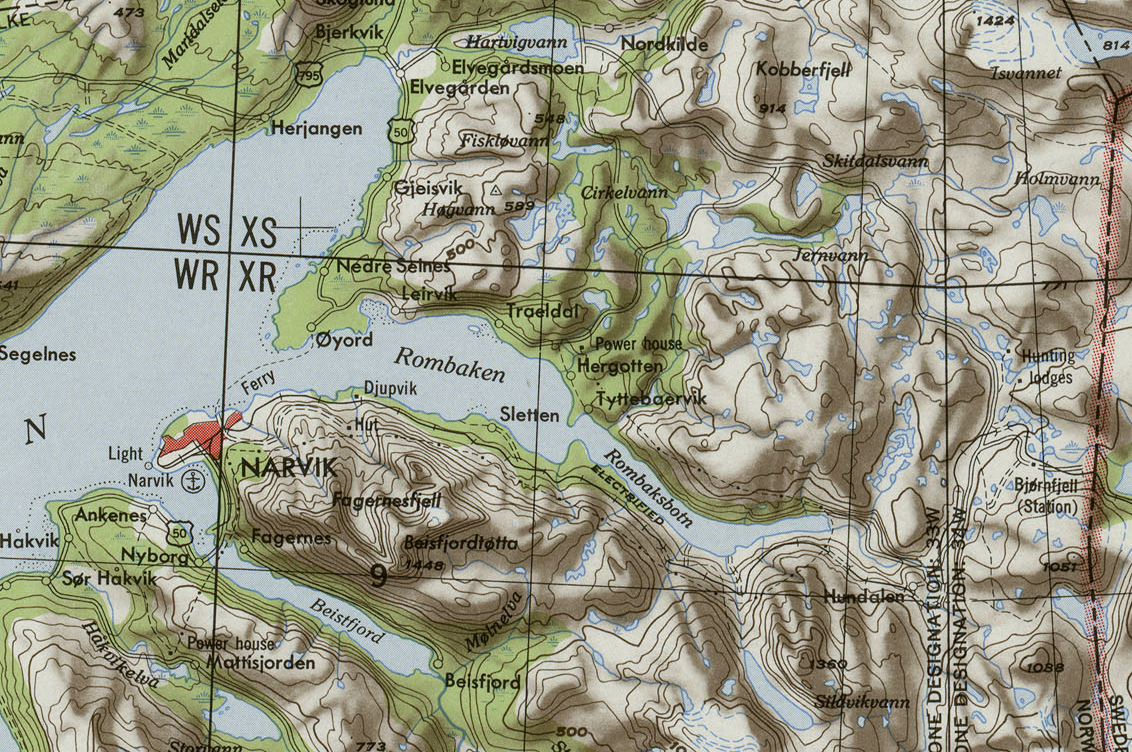
(Army Map Service (AMS&S), Corps of Engineers, U. S. Army, Washigton D. C. 1952)
June 2
2200 - The weather is cloudy with a moderate southwest wind. The barges departed Narvik and began their approach to Straumsnes.
2300 - After a very short artillery preparation, the Norwegians launched a series of soundings into the German position on both sides of the road leading to Bjørnfjell station and the border. Shortly afterwards, the Chasseurs Alpins of the 14th BCA did the same on the other side of lake Jernvatnet, north of the fjord, as well as the French and Poles, to the south. But the orders were not to exhaust themselves in vain assaults, just to divert attention and fix the defenders.
2310 - Because of the cloudy weather on land, the air cover will be rovided by the Sea Gladiator and Skua from Ark Royal and Glorious. The first of the patrols that will continue throughout the day made its appearance.
2320 - The destroyer HMS Ardant entered the Rombaks fjord and was in position around 2345 in the Rombaksbotn, not far from the wreck of the German destroyer Georg Thiele, from where it started a heavy fire on the German positions north and south of the fjord. At this point, the barges left the shelter of the promontory that encircled the bottom of the fjord and headed for the small beach at its end.
The wreck of the Georg Thiele

(United Kingdom Government, public domain)
June 3rd
0010 - The landing of the fourth company and the four tanks was carried out without any opposition - the Germans being very busy on the whole length of the front line, they were not aware of the assault until the very last moment - and the exploitation starts.
0030 - The Ardent, not being able to support any more the progression of this unit heading into the valley, turned back and joined less narrowed waters.
0040 - The second wave landed and, as soon as the 2nd battalion of the 13th DBMLE was complete, the fifth company began the progression westward along the southern bank of the fjord, while the sixth company was going to secure the northern flank and support the fourth company.
0045 - But Dietl sent his meager reserves (two companies) towards Hundalen as soon as he understood the maneuver.
0100 - The fourth company of the 13th DBMLE is blocked in the ascent and cannot reach the railroad in spite of the support of tanks.
0120 - With the arrival of the reinforcements which directly climbed the slope up to the railroad 320 m above the beach, the situation changes quickly : the defenses along the fjord, caught in a pincer movement, collapse half an hour later and the 1st battalion of the 13th DBMLE can progress along the railroad threatening the position of Hundalen.
0230 - The Germans have no other solution than to withdraw through the railroad tunnel while the troops engaged against the Poles in the south are unable to withdraw. Dietl lost almost a battalion.
0400 - In the north, Norwegians and Frenchs did not make much progress - they had no mission to break through the rocky terrain, which was very favorable to defense - but in the south, three battalions now threatened Dietl's headquarters, which could only order a withdrawal to form a last square and avoid being cut off from the border.
0500 - Warned around two o'clock, the X. Fliegerkorps sent bombers to support the besieged. He 111s arrived at the entrance of the Vestfjord but the low ceiling prevented them from entering the Rombaks fjord. They were caught by the British fighters and did not insist on taking refuge in the clouds.
0900 - Stuka appeared in the sky but could not intervene because of the clouds and the rain. The Gladiators scattered them brutally.
1700 - At the end of the day (if one can say in summer in these latitudes) the Germans controlled only a small area near the Swedish border, bombarded by 120 mm from the destroyer HMS Acasta, which came back to the bottom of the fjord to do a last cleaning in addition to the Norwegian mountain artillery. The shots, controlled by optical signals from the beach (radio waves are not very efficient in this iron-rich terrain), demoralized the defenders.
1800 - Dietl crossed the border with less than 2,000 men who quickly boarded the trains that the Swedes, anticipating the end of the war, had brought. Direction of internment for the mountaineers and parachutists, the sailors will be repatriated as castaways.
Map of the operations :
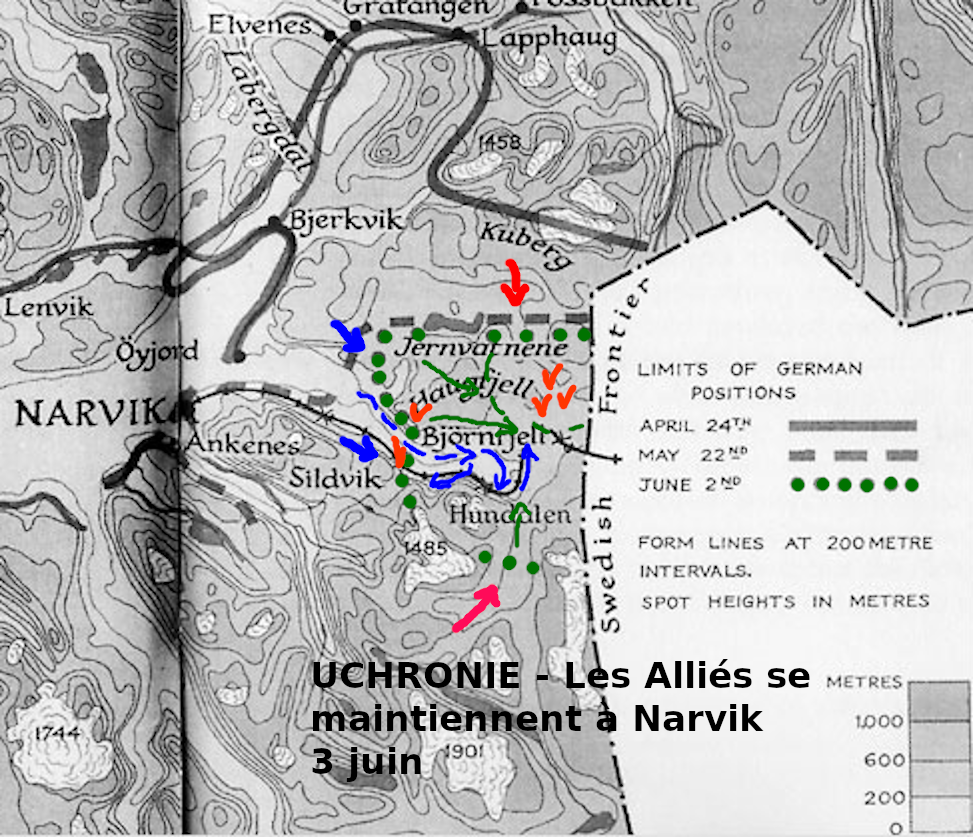
(map base: THE CAMPAIGN IN NORWAY, T. K. Derry, D. Phil (Oxon.), LONDON 1952, HMSO)
May 29 - Headquarters of the allied forces in Harstad
General Antoine Béthouart presents the situation:
"Dietl's 3rd Mountain Division is now pressed from all sides, but the progress of our troops is difficult in a very rugged rocky terrain still covered with snow for the most part. General Dietl has tightened his position and relies on the topography for his defense, every meter gained costs us dearly.
To break through the last resistance, we would have to renew the amphibious assault, this time at the bottom of the Rombaken fjord, which would allow us to strike at the heart of the enemy's position by moving up towards the Katterat railway station in the village of Hundalen to turn the southern defences of the German pocket. We can hope for a disorganization of the entire southern flank."
Admiral Lord William Henry Dudley Boyle, Earl of Cork and Orrery, commander of the Franco-British naval forces, who had been advocating a direct assault on Narvik since the beginning of the operation, approved and promised the support of the Royal Navy even in the tight waters of the fjord bottom.
Captain Loben E. H. Maund, Chief of Naval Staff, former head of the Inter-Service Training and Development Centre (ISTDC), which was responsible for developing methods and equipment for combined operations, was not to be outdone and finally saw his work come to fruition day after day.
General Claude Auchinleck, although not directly concerned because all British land forces are now on the Bodø front, fully supports the idea. As well as the Norwegian General Carl Gustav Fleischer -whose two brigades suffered the most in an open terrain- who also saw the opportunity to finish quickly and to shift the effort to the south.
General Sylvestre-Gérard Audet, commander of the French Expeditionary Corps in Scandinavia (CEFS) was satisfied, not that he feared a refusal - relations between the Allies and the Norwegians were excellent, especially since Auchinleck had replaced General Mackesy, who had had differences of opinion with Admiral Boyle - but he was comforted by the speed and unanimity of the reaction of the participants.
The operation started on 2 June shortly before midnight to limit the air risk, as Værnes was in a short period of darkness at that time, whereas it was daylight in Narvik and Bardufoss; there could be Allied cover, but even if they asked for help, the German planes would not be able to take off quickly.
The 13th Legion Half-Brigade, now experienced in landing under enemy fire, will be in charge of the operation.
Opposing troops will be fixed by assaults beginning half an hour before the actual landing operation is launched, to the north by the Norwegians of the 16th Regiment of the 6th Division, to the west by the 14th BCA, to the southwest by the 1st Battalion of the 13th DBMLE and to the south by the Poles.
The assault wave will be composed of one LCM (16-ton payload) and three MLCs (10-ton payload) that will land four Hotchkiss H39 tanks, another MLC will carry about 100 men, and the three LCAs will also land a total of about 100 men. The disembarked company will advance to the bottom of the beach to secure it and will start the progression towards the railroad. The approach of the barges will be hidden until they enter the mile-long Rombaksbotn, which will be crossed in about 15 minutes. A destroyer will accompany them to provide fire support, particularly on the south bank to allow the French to advance on this side or, at least, to prevent any withdrawal movement by the defenders.
The craft will then rotate to a ship that has brought the other two companies of the 2nd Battalion as close as possible. One will have the mission of securing the northern flank and the other will head west to take the defenders of the southern shore of the fjord in reverse.
The destroyer will leave the area as soon as the first wave has started its advance.
Map of the area around Narvik:

(Army Map Service (AMS&S), Corps of Engineers, U. S. Army, Washigton D. C. 1952)
June 2
2200 - The weather is cloudy with a moderate southwest wind. The barges departed Narvik and began their approach to Straumsnes.
2300 - After a very short artillery preparation, the Norwegians launched a series of soundings into the German position on both sides of the road leading to Bjørnfjell station and the border. Shortly afterwards, the Chasseurs Alpins of the 14th BCA did the same on the other side of lake Jernvatnet, north of the fjord, as well as the French and Poles, to the south. But the orders were not to exhaust themselves in vain assaults, just to divert attention and fix the defenders.
2310 - Because of the cloudy weather on land, the air cover will be rovided by the Sea Gladiator and Skua from Ark Royal and Glorious. The first of the patrols that will continue throughout the day made its appearance.
2320 - The destroyer HMS Ardant entered the Rombaks fjord and was in position around 2345 in the Rombaksbotn, not far from the wreck of the German destroyer Georg Thiele, from where it started a heavy fire on the German positions north and south of the fjord. At this point, the barges left the shelter of the promontory that encircled the bottom of the fjord and headed for the small beach at its end.
The wreck of the Georg Thiele

(United Kingdom Government, public domain)
June 3rd
0010 - The landing of the fourth company and the four tanks was carried out without any opposition - the Germans being very busy on the whole length of the front line, they were not aware of the assault until the very last moment - and the exploitation starts.
0030 - The Ardent, not being able to support any more the progression of this unit heading into the valley, turned back and joined less narrowed waters.
0040 - The second wave landed and, as soon as the 2nd battalion of the 13th DBMLE was complete, the fifth company began the progression westward along the southern bank of the fjord, while the sixth company was going to secure the northern flank and support the fourth company.
0045 - But Dietl sent his meager reserves (two companies) towards Hundalen as soon as he understood the maneuver.
0100 - The fourth company of the 13th DBMLE is blocked in the ascent and cannot reach the railroad in spite of the support of tanks.
0120 - With the arrival of the reinforcements which directly climbed the slope up to the railroad 320 m above the beach, the situation changes quickly : the defenses along the fjord, caught in a pincer movement, collapse half an hour later and the 1st battalion of the 13th DBMLE can progress along the railroad threatening the position of Hundalen.
0230 - The Germans have no other solution than to withdraw through the railroad tunnel while the troops engaged against the Poles in the south are unable to withdraw. Dietl lost almost a battalion.
0400 - In the north, Norwegians and Frenchs did not make much progress - they had no mission to break through the rocky terrain, which was very favorable to defense - but in the south, three battalions now threatened Dietl's headquarters, which could only order a withdrawal to form a last square and avoid being cut off from the border.
0500 - Warned around two o'clock, the X. Fliegerkorps sent bombers to support the besieged. He 111s arrived at the entrance of the Vestfjord but the low ceiling prevented them from entering the Rombaks fjord. They were caught by the British fighters and did not insist on taking refuge in the clouds.
0900 - Stuka appeared in the sky but could not intervene because of the clouds and the rain. The Gladiators scattered them brutally.
1700 - At the end of the day (if one can say in summer in these latitudes) the Germans controlled only a small area near the Swedish border, bombarded by 120 mm from the destroyer HMS Acasta, which came back to the bottom of the fjord to do a last cleaning in addition to the Norwegian mountain artillery. The shots, controlled by optical signals from the beach (radio waves are not very efficient in this iron-rich terrain), demoralized the defenders.
1800 - Dietl crossed the border with less than 2,000 men who quickly boarded the trains that the Swedes, anticipating the end of the war, had brought. Direction of internment for the mountaineers and parachutists, the sailors will be repatriated as castaways.
Map of the operations :

(map base: THE CAMPAIGN IN NORWAY, T. K. Derry, D. Phil (Oxon.), LONDON 1952, HMSO)





